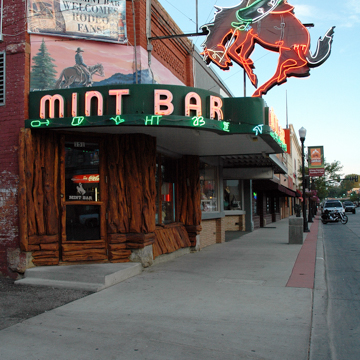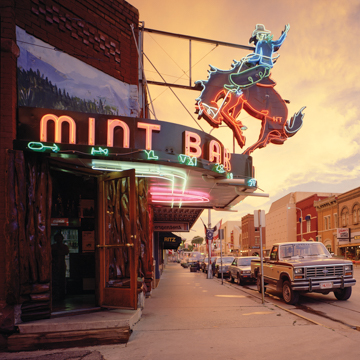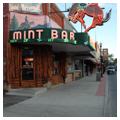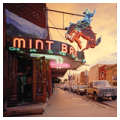You are here
Mint Bar
Soon after it opened on Main Street in 1907, the Mint Saloon (now Bar) became one of the most popular establishments in Sheridan. In 1923, with Prohibition in full force, the Mint rebranded itself the “Mint Cigar Company and Soda Shop” under new owner Oran Moore. The bar was secretly set up in the back room, and continued to operate as a speakeasy. Despite the secret liquor sales, Moore closed the Mint in 1930 due to other economic concerns. A series of offices occupied the building until the repeal of Prohibition in 1933.
That year the Mint Bar reopened with a new liquor license and new owners Archie Wilson and Robert J. Thirwell. They constructed an addition to the rear of the building to enlarge the former speakeasy into a gambling parlor. The bar continued to grow in popularity, attracting locals and tourists alike. In 1938, Wilson and new owner Jack Kane installed the now-famous neon bucking horse sign. This sign is immediately recognizable from up and down Main Street. The phrase “meet you at the Mint” began soon after the neon sign was installed.
The Mint Bar experienced its heyday from the 1940s through the 1960s, with the national popularity of Hollywood Westerns. At the Mint, real-life cowboys and ranch hands drank and gambled amid tourists hoping for a glimpse of the “real West.” During these decades, the Mint became nationally known as a must-see destination en route to Yellowstone National Park. In the 1940s the bar underwent interior and exterior renovations. The knotty-pine paneled walls of the bar were decorated with unusual taxidermy specimens and brands burned into cedar shingles. Today, the bar retains much of its original look from this period, with almost every square inch of the interior walls covered in Western memorabilia, from original newspaper clippings and historic photographs to arrowheads and over 9,000 brands, each on its own block of cedar. The bar extends about half the length of the interior, with knotty-pine booths and a pool table to the rear.
The Mint Bar is a one-story, rectangular brick building with a narrow facade facing west on Main Street and a northwest-facing corner entrance. The entrance and the storefront window on the west facade were framed with gnarled and knotty pine logs in the 1940s renovation—the only storefront of its kind in Sheridan. The logs terminate under the large, curved metal canopy, which shelters the entrance and supports the neon signs dominating the front of the Mint. The bar’s name is written in neon lettering across the west and north sides of the canopy, with small neon brands below. The famous cowboy on his bucking horse rises from the top of the canopy; the horse is outlined in red and white neon, while the rider, holding a rope in one hand and raising the other hand high in the air, is outlined in green and blue. A mural above the canopy depicts a cowboy riding towards the mountains at sunset. Decorative corbelled brick coursing extends above the mural to the cornice. A large sign, painted directly on the brick of the north elevation, notes that the bar has been, since 1907, a place “Where Great Friends Meet.”
The bar has had a series of owners and managers since it reopened in 1933. It continues to serve as a popular gathering place for local ranchers and residents, as well as an attraction for national and international visitors.
References
Flynn, Katherine. “The Mint Bar in Sheridan, Wyoming.” National Trust for Historic Preservation. Accessed April 16, 2016. https://savingplaces.org/.
Writing Credits
If SAH Archipedia has been useful to you, please consider supporting it.
SAH Archipedia tells the story of the United States through its buildings, landscapes, and cities. This freely available resource empowers the public with authoritative knowledge that deepens their understanding and appreciation of the built environment. But the Society of Architectural Historians, which created SAH Archipedia with University of Virginia Press, needs your support to maintain the high-caliber research, writing, photography, cartography, editing, design, and programming that make SAH Archipedia a trusted online resource available to all who value the history of place, heritage tourism, and learning.




